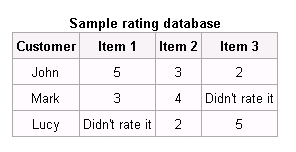Slope One 之一 : 簡單高效的協同過濾算法(轉)(
原文地址:http://blog.sina.com.cn/s/blog_4d9a06000100am1d.html
現在做的一個項目中需要用到推薦算法, 在網上查了一下. Beyond Search介紹了一個協同過濾算法(Collaborative Filtering) : Slope One;和其它類似算法相比, 它的最大優點在于算法很簡單, 易于實現, 執行效率高, 同時推薦的準確性相對很高;
基本概念
Slope One的基本概念很簡單, 例子1, 用戶X, Y和A都對Item1打了分. 同時用戶X,Y還對Item2打了分, 用戶A對Item2可能會打多少分呢?
| User |
Rating to Item 1 |
Rating to Item 2 |
| X |
5 |
3 |
| Y |
4 |
3 |
| A |
4 |
? |
根據SlopeOne算法, 應該是:4 - ((5-3) + (4-3))/2 = 2.5.
解釋一下. 用戶X對Item1的rating是5, 對Item2的rating是3, 那么他可能認為Item2應該比Item1少兩分. 同時用戶Y認為Item2應該比Item1少1分. 據此我們知道所有對Item1和Item2都打了分的用戶認為Item2會比Item1平均少1.5分. 所以我們有理由推薦用戶A可能會對Item2打(4-1.5)=2.5分;
很簡單是不是? 找到對Item1和Item2都打過分的用戶, 算出rating差的平均值, 這樣我們就能推測出對Item1打過分的用戶A對Item2的可能Rating, 并據此向A用戶推薦新項目.
這里我們能看出Slope One算法的一個很大的優點, 在只有很少的數據時候也能得到一個相對準確的推薦, 這一點可以解決Cold Start的問題.
加權算法
接下來我們看看加權算法(Weighted Slope One). 如果有100個用戶對Item1和Item2都打過分, 有1000個用戶對Item3和Item2也打過分. 顯然這兩個rating差的權重是不一樣的. 因此我們的計算方法是
(100*(Rating 1 to 2) + 1000(Rating 3 to 2)) / (100 + 1000)。更詳細的加權算法實例:請看這里
上面討論的是用戶只對項目的喜好程度打分.還有一種情況下用戶也可以對項目的厭惡程度打分. 這時可以使用雙極SlopeOne算法(BI-Polar SlopeOne). 我還在研究這篇論文,搞懂了再寫吧, 呵呵;
Slope One 算法是由 Daniel Lemire 教授在 2005 年提出. 這里可以找到論文原文(PDF);上面也列出了幾個參考實現. 現在有Python, Java和Erlang, 還沒有C#.這篇: tutorial about how to implement Slope One in Python是一個很好的怎么實現SlopeOne并使用它來推薦的例子。
Slope One 算法 (三) :加權平均實例
原文地址:http://blog.sina.com.cn/s/blog_4d9a06000100am69.html
- 例子:
-

- 首先計算item1和item2的平均差值,((5-3)+(3-4))/2=0.5,還有item1和item3的平均差值,就是5-2=3,然后推算lucy對item1的評分,根據item1和item2的平均差值來看lucy對item1的評分可能為2+0.5=2.5,同理根據item1和item3的平均差值lucy對item1的評分可能為5+3=8.
- 現在如何取舍那?使用加權平均數應該是一種比較好的方法:
 (因為2.5是根據兩個值推算的,8是通過一個只推算的)
(因為2.5是根據兩個值推算的,8是通過一個只推算的)
- slope one 算法差不多真的就是這么簡單了!
- 有一個開源的Java程序taste里面有一個完整的slope one算法的實現,包括程序和一個關于grouplens數據的實例程序(或者說是驗證程序……)。
- 個人覺得slope one 很好、很強大呀!足夠簡單,推薦準確度也不遜色與其他復雜的推薦算法(當然,這個東西更大程度上取決與數據樣本)。而且taste程序寫的也很不錯,稍加改造應該就可以用了。
Slope One 之二: C#實現
原文地址:http://blog.sina.com.cn/s/blog_4d9a06000100am69.html
上一篇簡單介紹了Slope One算法的概念, 這次介紹C#實現
使用基于Slope One算法的推薦需要以下數據:
1. 有一組用戶
2. 有一組Items(文章, 商品等)
3. 用戶會對其中某些項目打分(Rating)表達他們的喜好
Slope One算法要解決的問題是, 對某個用戶, 已知道他對其中一些Item的Rating了, 向他推薦一些他還沒有Rating的Items, 以增加銷售機會. :-)
一個推薦系統的實現包括以下三步:
1. 計算出任意兩個Item之間Rating的差值
2. 輸入某個用戶的Rating記錄, 推算出對其它Items的可能Rating值
3. 根據Rating的值排序, 給出Top Items;
第一步:例如我們有三個用戶和4個Items, 用戶打分的情況如下表.
| Ratings |
User1 |
User2 |
User3 |
| Item1 |
5 |
4 |
4 |
| Item2 |
4 |
5 |
4 |
| Item3 |
4 |
3 |
N/A |
| Item4 |
N/A |
5 |
5 |
在第一步中我們的工作就是計算出Item之間兩兩的打分之差, 也就是使說計算出以下矩陣:
| |
Item1 |
Item2 |
Item3 |
Item4 |
| Item1 |
N/A |
0/3 |
2/2 |
-2/2 |
| Item2 |
0/3 |
N/A |
2/2 |
-1/2 |
| Item3 |
-2/2 |
-2/2 |
N/A |
-2/1 |
| Item4 |
2/2 |
1/2 |
2/1 |
N/A |
考慮到加權算法, 還要記錄有多少人對這兩項打了分(Freq), 我們先定義一個結構來保存Rating:
public class Rating
{
public float Value { get; set; }
public int Freq { get; set; }
public float AverageValue
{
get {return Value / Freq;}
}
}
我決定用一個Dictionary來保存這個結果矩陣:
public class RatingDifferenceCollection : Dictionary<string, Rating>
{
private string GetKey(int Item1Id, int Item2Id)
{
return Item1Id + "/" + Item2Id;
}
public bool Contains(int Item1Id, int Item2Id)
{
return this.Keys.Contains<string>(GetKey(Item1Id, Item2Id));
}
public Rating this[int Item1Id, int Item2Id]
{
get {
return this[this.GetKey(Item1Id, Item2Id)];
}
set { this[this.GetKey(Item1Id, Item2Id)] = value; }
}
}
接下來我們來實現SlopeOne類. 首先創建一個RatingDifferenceCollection來保存矩陣, 還要創建HashSet來保持系統中總共有哪些Items:
public class SlopeOne
{
public RatingDifferenceCollection _DiffMarix = new RatingDifferenceCollection(); // The dictionary to keep the diff matrix
public HashSet<int> _Items = new HashSet<int>(); // Tracking how many items totally
方法AddUserRatings接收一個用戶的打分記錄(Item-Rating): public void AddUserRatings(IDictionary<int, float> userRatings)
AddUserRatings中有兩重循環, 外層循環遍歷輸入中的所有Item, 內層循環再遍歷一次, 計算出一對Item之間Rating的差存入_DiffMarix, 記得Freq加1, 以記錄我們又碰到這一對Items一次:
Rating ratingDiff = _DiffMarix[item1Id, item2Id];
ratingDiff.Value += item1Rating - item2Rating;
ratingDiff.Freq += 1;
對每個用戶調用AddUserRatings后, 建立起矩陣. 但我們的矩陣是以表的形式保存:
| |
Rating Dif |
Freq |
| Item1-2 |
0 |
3 |
| Item1-3 |
1 |
2 |
| Item2-1 |
0 |
3 |
| Item2-3 |
1 |
2 |
| Item3-1 |
-1 |
2 |
| Item3-2 |
-1 |
2 |
| Item1-4 |
-1 |
2 |
| Item2-4 |
-0.5 |
2 |
| Item3-4 |
-2 |
1 |
| Item4-1 |
1 |
2 |
| Item4-2 |
0.5 |
2 |
| Item4-3 |
2 |
1 |
第二步:輸入某個用戶的Rating記錄, 推算出對其它Items的可能Rating值:
public IDictionary<int, float> Predict(IDictionary<int, float> userRatings)
也是兩重循環, 外層循環遍歷_Items中所有的Items; 內層遍歷userRatings, 用此用戶的ratings結合第一步得到的矩陣, 推算此用戶對系統中每個項目的Rating:
Rating itemRating = new Rating(); // Prediction of this user's rating
...